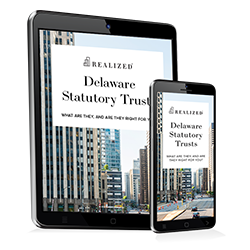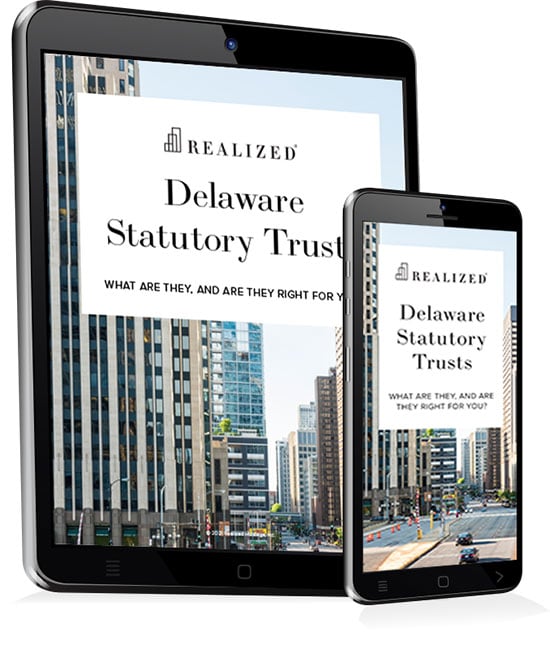
Investors have plenty of options when it comes to alternative investments, with different vehicles offering varying combinations of growth potential, risk management, and diversification. REITs, private equity, and hedge funds are commonly used strategies—but one structure with specific real estate applications is the Delaware Statutory Trusts (DSTs).
DSTs are often used in 1031 exchanges and offer features such as passive ownership and potential tax deferral. These characteristics may appeal to investors seeking limited management responsibility or estate planning flexibility.
In this article, Realized 1031 explores the structure and use cases of DSTs to help investors understand how they compare to other alternative real estate options.
About Delaware Statutory Trusts
A DST is an investment vehicle recognized as a trust entity, which allows investors to pool funds and purchase income-generating assets — often institutional-grade. In exchange, the investor owns fractional interests in the DST and may receive distributions from the underlying properties’ income. The amount distributed to an investor is generally proportional to the interests owned.
As the name implies, DSTs were first codified under Delaware law. However, their use has expanded nationally, particularly after the issuance of Revenue Ruling 2004-86 made DSTs eligible for 1031 exchanges. This permitted DSTs to qualify as replacement property in 1031 exchanges under certain conditions, increasing their applicability within tax-deferred real estate strategies.
DST Investment Features: Structural Characteristics and Investor Considerations
Given their legal and operational structure, Delaware Statutory Trusts (DSTs) offer a range of features that may support specific real estate investment goals. Below are several commonly referenced attributes.
1. 1031 Exchange Eligibility
As outlined in IRS Revenue Ruling 2004-86, DSTs can qualify as replacement property in a 1031 exchange under certain conditions. 1031 exchanges are a tax-deferred strategy that allows you to exchange one qualifying property for another of like kind, potentially deferring capital gains taxes if the transaction meets all regulatory requirements. If done correctly, the like-kind exchange delays tax payments for capital gains.
Before the revenue ruling, only real property was allowed in the 1031 exchange. The inclusion of fractional interests—such as those offered through DSTs—broadened the options available to investors seeking passive exposure while meeting 1031 exchange rules.
2. Passive Ownership Structure
Investors in a DST don’t have any control over the daily operations or management of the underlying properties, and a third-party sponsor or affiliated manager handles these responsibilities. This arrangement may appeal to those seeking limited direct involvement, particularly individuals looking to reduce hands-on management responsibilities as part of broader estate or retirement planning.
3. Access to Institutional-grade Assets
By pooling capital from multiple investors, DSTs may be able to acquire larger commercial properties than an individual investor could access on their own. These can include:
- Large Office Buildings
- Retail Centers
- Hotels
- Warehouse Facilities
- Upscale Apartment Complexes
- Industrial Parks
These asset types are often held by institutional investors, and DST participation allows individuals to gain fractional exposure, subject to offering terms and risk factors.
4. Low Entry Thresholds
DST offerings typically require lower capital commitments than direct real estate ownership, with some starting around $100,000. Additionally, in a 1031 exchange, you are allowed to identify and acquire many assets so long as the total value is not higher than 200% of the replacement property’s value. You can split up the proceeds to enter multiple DSTs and gain access to more sectors or geographic locations.
5. Targeted Income Distributions
Many DSTs invest in stabilized, income-producing properties with professional management. Depending on the offering, this may result in scheduled distributions based on net operating income. However, distributions are not guaranteed, and investors should carefully review offering documents, as well as risks related to market performance, tenant stability, and sponsor management.
Important Considerations Before Investing in a DST
While Delaware Statutory Trusts (DSTs) offer structural features that may align with certain investment goals, they are not appropriate for all investors. Keeping the following considerations in mind can help inform a careful evaluation before committing capital to a DST offering.
- Illiquid Asset: DSTs are generally designed to be held for a fixed period, often 5–10 years, during which investor capital is not readily accessible. Although fractional interests may be sold in limited circumstances, there isn't a deep secondary market where you can easily find willing buyers
- Limited Investor Control DST investors do not participate in the active management of the underlying property, which may not be suitable for investors who still want more control over their assets. Directly owning a property may offer greater flexibility.
- To maintain 1031 eligibility, DSTs have restrictions on refinancing and capital improvements. While this rule reduces risk, it can also limit upside potential.
- Accredited Investor Requirements: Not all investors can enter DSTs. In most cases, only accredited investors are allowed to join, those who have a net worth higher than $1 million or a yearly income of $200,000 and above.
Which Type of Investor Might Consider a DST?
Given the structure and regulatory characteristics of Delaware Statutory Trusts (DSTs), they may align with the goals of certain investors under specific circumstances. The following profiles illustrate common use cases, though suitability should always be assessed based on individual objectives, risk tolerance, and financial planning needs:
- Those who are conducting a 1031 exchange
- Retirees seeking less involvement in their assets, like rental properties
- Investors who want to reposition their portfolio to improve diversification
- Estate planners who are exploring structures that may facilitate passive ownership and long-term capital deployment.
Wrapping Up: Key Characteristics of DSTs in Alternative Real Estate Investing
Delaware Statutory Trusts (DSTs) represent one of several structures available within the alternative real estate investment space. They offer a range of features—such as potential tax deferral through 1031 exchange eligibility, access to professionally managed commercial properties, and fractional ownership—that may appeal to certain investors.
For those seeking passive property exposure or considering options to complete a 1031 exchange without taking on direct management responsibilities, DSTs may be worth evaluating. As with any investment strategy, it’s important to assess whether the structure aligns with your financial goals, liquidity needs, and risk tolerance.
The tax and estate planning information offered by the advisor is general in nature. It is provided for informational purposes only and should not be construed as legal or tax advice. Always consult an attorney or tax professional regarding your specific legal or tax situation.
Article written by: Story Amplify. Story Amplify is a marketing agency that offers services such as copywriting across industries, including financial services, real estate investment services, and miscellaneous small businesses.
Sources:
https://delcode.delaware.gov/title12/c038/sc01/
https://www.irs.gov/irb/2004-33_IRB
https://www.investopedia.com/terms/l/like-kind_exchange.asp
https://www.sec.gov/Archives/edgar/data/1388132/000103570407000101/d42970sbv2.htm
https://www.sec.gov/resources-small-businesses/capital-raising-building-blocks/accredited-investors



